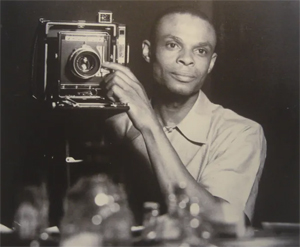John W. Mosley facts for kids
Quick facts for kids
John W. Mosley
|
|
|---|---|

self portrait
|
|
| Born |
John W. Mosley
May 19, 1907 |
| Died | October 1, 1969 (aged 62) |
| Nationality | American |
| Known for | Photography |
John W. Mosley (born May 19, 1907 – died October 1, 1969) was a talented photographer. He taught himself how to take pictures. For over 30 years, he took photos of everyday life for African Americans in Philadelphia, Pennsylvania. This was during important times like World War II and the Civil Rights Movement.
His pictures were printed in many newspapers and magazines. These included The Philadelphia Tribune, The Pittsburgh Courier, and Jet magazine. People called Mosley a "cultural warrior." He helped save a true record of African-American life. His work showed real stories, fighting against wrong ideas about black history and culture.
More than 300,000 of Mosley's photos are kept at Temple University. They are part of the Charles L. Blockson Afro-American Collection. His amazing work has also been shown in art exhibits. You could see his photos at the Philadelphia International Airport and the Woodmere Art Museum.
Contents
Early Life and Photography Start
John W. Mosley was born in 1907 in Lumberton, North Carolina. His dad was a minister and a barber. John played football when he was in high school.
In the 1920s, he started learning photography by himself. He used a simple box camera. He also studied at Johnson C. Smith University.
In 1934, Mosley moved to Philadelphia. This was part of the Great Migration. Many African Americans moved from the South to northern cities then. In Philadelphia, he got a job at Barksdale Photography Studio. Later, he had his own photo studio at the Christian Street YMCA.
Capturing Life Through His Lens
Mosley became a very successful photographer. This was from the 1930s to the 1960s. He was known for taking pictures at many events. Sometimes, he would photograph four events in one day. He worked seven days a week!
He traveled all over Philadelphia on public transit. He always carried his cameras and other gear. Mosley used black and white film for his photos. He often used a large Graflex Speed Graphic camera. He also used a medium-sized Rollieflex camera.
Mosley was very proud of his heritage. He chose to show the black community in a positive way. He photographed families and friends at many different events. These included weddings, picnics, church gatherings, and sporting events. He also took pictures at concerts, fancy parties, and civil rights protests.
During a time of racism, he highlighted the achievements of black leaders. He photographed famous black celebrities and athletes.
Famous Faces and Places
John W. Mosley photographed many important people. Some of them were bandleader Duke Ellington and basketball star Wilt Chamberlain. He also captured tennis player Ora Washington and singer Billie Holiday. Other famous people included Martin Luther King Jr. and Marian Anderson. He even photographed Eleanor Roosevelt and President Richard Nixon.
He also took pictures of important places in Philadelphia. These included Nixon's Grand Theatre and the Earle Theatre. He also photographed Chicken Bone Beach in Atlantic City. The Pyramid Club was a big center for African-American culture. Mosley was the club's official photographer for many years. He even made an annual photo album for them.
Mosley was one of the first black Americans to be a syndicated photographer. This means his photos were sold to many different newspapers. His work was published in newspapers like The Philadelphia Tribune and The Pittsburgh Courier. His photos also appeared in Jet magazine.
Mosley's Lasting Legacy
The Charles L. Blockson Afro-American Collection at Temple University holds over 300,000 of Mosley's photographs. This collection is very important. It helps us understand the history and culture of people of African descent.
Diane Turner is the curator of the Blockson Collection. She says Mosley's work is vital. It helps fight against "negative stereotypes and false interpretations of African-American history." She explains that Mosley's photos show "an accurate record of Black Philadelphia."
Charles L. Blockson wrote a book about Mosley's life. It is called The journey of John W. Mosley (1992).
Mosley's photos have been shown in special exhibits. One was called A Celebration of African-American Life in Philadelphia, 1930's – 1960's. It was shown at the Philadelphia International Airport in 2012. Another big show was A Million Faces: The Photography of John W. Mosley. This exhibit was at the Woodmere Art Museum in 2016.

